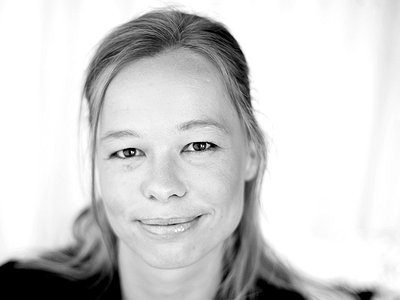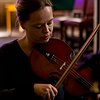Part 1
Name: Anne Hytta
Nationality: Norwegian
Occupation: Musician/Composer
Current Release: Dirr on Hubro
Recommendations: The beauty and outer-worldly sound of John Cage’s String quartet in four parts, really captivated me. Something very exotic would be an album of my master teacher, Einar Løndal (1914 – 2006), I would recommend both the release Løndalstonar III or Løndalsspel. You may think it’s just another folk fiddler with his typical music, but once you start listening, you’ll understand that his interpretations are quite remarkable.
Website / Contact: If you enjoyed this interview with Anne Hytta, visit her official website for more information and contact details www.annehytta.com
When did you start writing/producing music - and what or who were your early passions and influences? What is it about music and/or sound that drew you to it?
I made a few songs as a child, being a piano student, but it was nothing more than melodic sketches. Growing up, it took me quite a while to pick up on that trace, probably because learning the complicated, intricate dialect of traditional music for hardanger fiddle took up all my focus.
My teacher in this repertoire, Einar Løndal (1914 – 2006), was a great master of the traditional music for the hardanger fiddle, with a highly precise, advanced set of melodic motifs that are the foundation of our tradition. So, it wasn’t until I was a student at the Ole Bull academy that I felt the urge to create. At first didn’t know what it would be, but gradually I started putting together the elements that would form my first pieces.
For most artists, originality is first preceded by a phase of learning and, often, emulating others. How would you describe your own development as an artist and the transition towards your own voice? What is the relationship between copying, learning and your own creativity?
For me, copying can’t be praised enough. We are living in a time when copying is generally frowned upon, the mode of our time is the idea that everything stems from yourself, but I think it is a misconception that originality and creativity corresponds with everything coming from your own mind. I learned a well-established style of shaping melodic lines; accents, phrasings, ornamentations, variation possibilities in monophonic music/modal music. Learning something so thoroughly has been an immense asset in my musical work, not least because at some point, when copying, you inevitably form your own style. Simply because you are your own person. It’s impossible to avoid, and nobody should be afraid of copying – as long as they also have no fear of searching for the sound from their own soul.
What were your main compositional- and production-challenges in the beginning and how have they changed over time?
My main challenge has been creating the form of a piece. So, I started a part-time study of composition at the Academy of music in Oslo where I learned the basics on how to start working, and how to shape the form of a piece. Most of it I don’t think about any longer, but it has influenced me for sure. My music is for a large part modal, and that gives a lot of people an itch, as they ache for a harmonic change in the music that never appears. But that is not the nature of my music. I’ve learned my strength is linear music, modal music, the developing of melodic lines and how to create and atmosphere around that.
What was your first studio like? How and for what reasons has your set-up evolved over the years and what are currently some of the most important pieces of gear for you?
Growing up, I used to rehearse in the old living room at my 200 year-old family farm house. It’s a rather dark room with lots of old, serious photo portraits of my ancestors, and I wasn’t a big fan of rehearsing there. But it was the room where I could be left in peace. Now, I very much like that room, and I have composed quite a lot of music there. For the last ten years, I’ve been working at Biermannsgården, a house and a rehearsing and concerting community in the center of Oslo. It’s a fantastic place, an old wooden house from 1700s in the middle of the city, with no traffic around; almost too good to be true. There’s quite a lot of musicians working there, and it’s an atmosphere that means a lot to me.
My gear is my fiddles and the Sibelius software.
How do you make use of technology? In terms of the feedback mechanism between technology and creativity, what do humans excel at, what do machines excel at?
I don’t use anything but Sibelius. Technology feels like an obstacle between me and music. Maybe it’s laziness. Technology frustrates me at times. I tell myself there are so many musicians making really good, new music with use of technology, and that it’s ok to be an analogue musician and composer – that the absence of technology can also create a unique expression in these times where, thanks to technologies, the possibilities seem unlimited.
Production tools, from instruments to complex software environments, contribute to the compositional process. How does this manifest itself in your work? Can you describe the co-authorship between yourself and your tools?
The co-authorship is me writing note by note on my Sibelius.
Collaborations can take on many forms. What role do they play in your approach and what are your preferred ways of engaging with other creatives through, for example, file sharing, jamming or just talking about ideas?
File-sharing – never tried. Jamming and talking about ideas – yes. This jamming and talking are very different in the different collaborations I am involved in. An example could be a quartet I am currently part of, with the excellent violinist Kari Rønnekleiv, Laura Marie Rueslåtten who is a carillonneur and violinist/composer Ole-Henrik Moe. Ole-Henrik has, for example, made a line of chords based on the overtones in a church bell. Exploring music like that is both very specific – if you don’t hit the exact notes, where there can be nuances of quarter notes, then you don’t get the desired timbre. At the same time, it is completely open – listening to the music of the others and developing the chords that contribute to developing the music is very difficult, very instructive and really inspiring.
In Slagr, I composed pieces with voices, then we started playing from that, with the others suggesting alterations or adjustments, and we build it from there.
Could you take us through a day in your life, from a possible morning routine through to your work? Do you have a fixed schedule? How do music and other aspects of your life feed back into each other - do you separate them or instead try to make them blend seamlessly?
My days are very different according to what I am currently working on. This spring I am in Denmark, working on an opera for children. So, every day, we rehearse until 3 pm, then afterwards I have time to work on my other projects. I don’t have a family, so my days tend to be quite filled with my musical work, which is a good thing, but also can be a little too intense at times.






